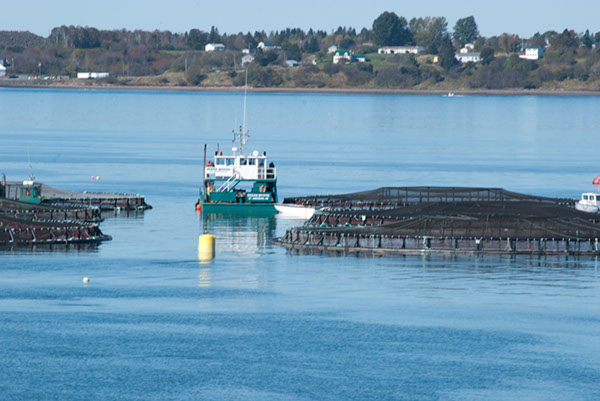Atlantic Salmon
Species Description
Atlantic salmon Salmo salar
Cultured in ocean net pens.
Season
Status
Wild Atlantic salmon in the Gulf of Maine are listed as an endangered species.
Maine Atlantic salmon aquaculture production peaked in 2000. After a period of decline, production numbers are increasing as management practices improve. In 2016, the Monterey Bay Aquarium Seafood Watch Program upgraded Maine-raised salmon to the list of yellow or “good alternative” seafoods.
Regulatory Authority
The Maine Department of Marine Resources (DMR) regulates the aquaculture industry in state waters. In addition, the Clean Water Act requires aquaculture facilities to have water discharge permits from the Department of Environmental Protection (DEP). The DEP inspects each salmon farm twice per year.
Harvest Method
Young salmon raised in freshwater hatcheries are placed in marine net pens where they grow to at least ten pounds over 18-24 months before being harvested.
Recreational Harvest
Wild sea-run Atlantic salmon in Maine rivers and coastal waters are endangered and all recreational fishing is prohibited. Maine salmon farms are private businesses in waters leased from the state; there is no public access.
For more information, visit the Maine Department of Inland Fisheries and Wildlife website.
Health Benefits & Risks
Salmon is relatively higher in fat than other fish, but it is an excellent source of omega-3 fatty acids and Vitamin D. Salmon is low in mercury. Much of the information available about other contaminants in farm-raised salmon is based on practices in other parts of the world and thus does not necessarily apply in Maine, where vaccines and integrated pest management have reduced chemical use and where preventative, broad-scale use of antibiotics, pesticides, growth enhancers, etc. is illegal. All therapeutic agents are FDA-approved and must be prescribed by a veterinarian to treat a specific diagnosed condition or disease. Atlantic salmon raised in Maine are routinely tested by the FDA for chemical residues and contaminants, to date none have been found.
View the 2021 US Food and Drug Administration’s fish consumption guidelines.
Buying & Preparing
It can be challenging to determine whether salmon is sourced from Maine waters, as Atlantic salmon are also farmed in places like Washington State, Canada, Chile, and Norway. However, many retailers label salmon with its country or region of origin, so checking the packaging is your best guide.
Atlantic salmon has a rich, buttery flavor and firm texture that shines with simple preparation; grill, bake, or pan-sear with minimal seasoning to let the natural taste come through.
Recipes
Certifications & Verifications
Montery Bay Aquarium Seafood Watch
Links
- NOAA Fisheries Species Directory
- NOAA Fisheries Fish Watch
- Maine Department of Marine Resources aquaculture page
- Maine Aquaculture Association
- For a history of salmon aquaculture, see Chapter 5 of The Great Salmon Run report.


